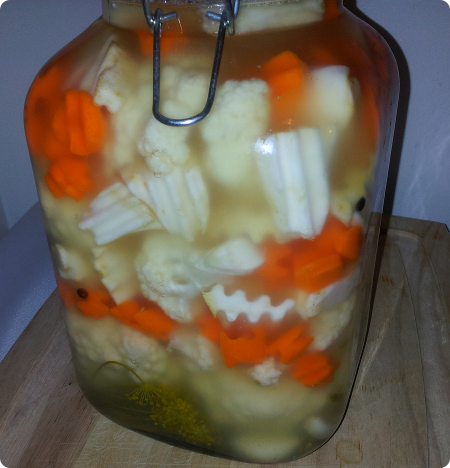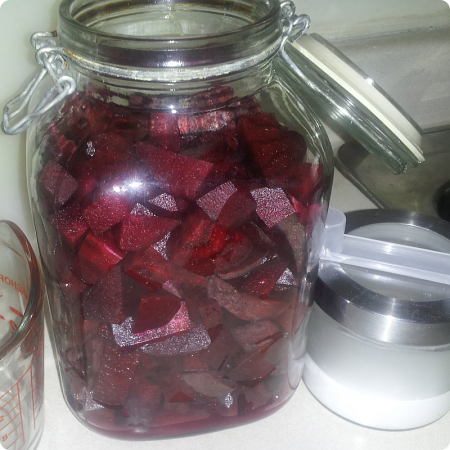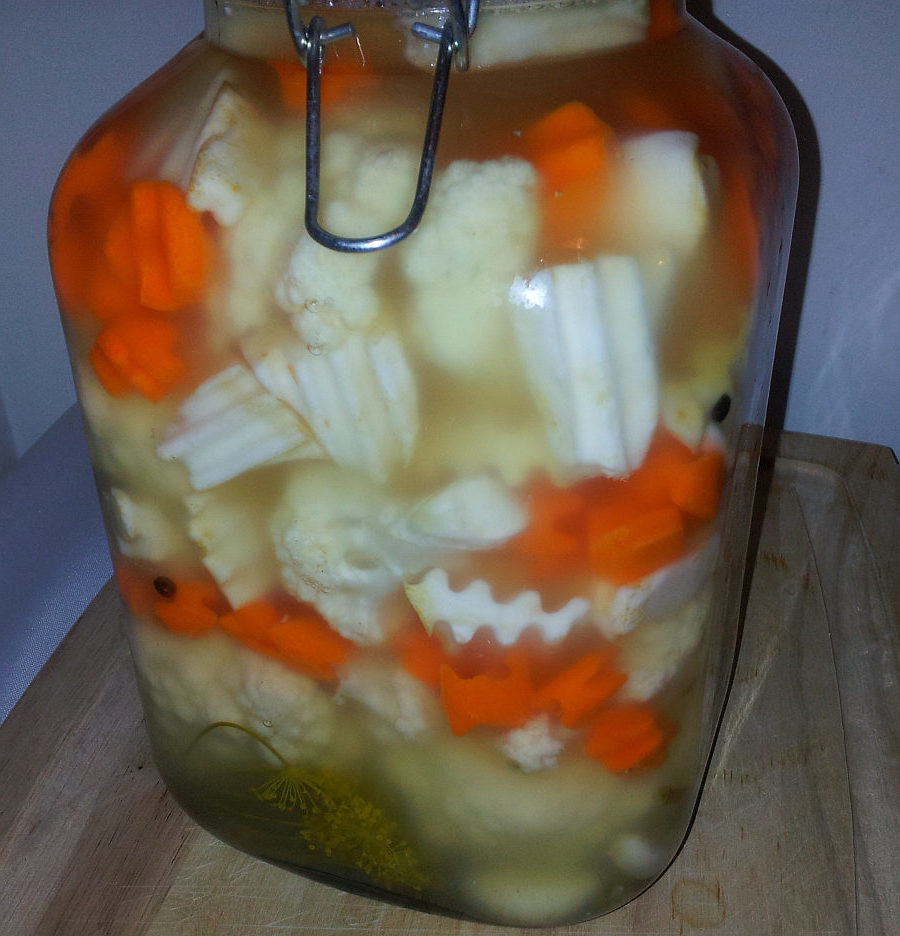 How To Make Sauerkraut, Probiotic Pickled Cucumbers, and Pickled Vegetables
How To Make Sauerkraut, Probiotic Pickled Cucumbers, and Pickled Vegetables
Sour pickles are obtained by fermenting various vegetables in a brine. The process is also known as lactofermentation, because of the lactic acid bacteria, which are responsible for the fermentation process. Sour pickles are a great probiotic fermented food, very nutritious, and healthy. The fermentation is very simple, it can be done by anyone at home, take a look at the instructions below.
In a 1 quart mason jar add your vegetables, nicely cut on a mandolin, or just cut. I usually put cauliflower, carrots, small cabbage cut in two or four, small onions, celery root, and beets. I add hot peppers for spiciness, but that is totally up to you. Add garlic cloves, black pepper, and dill for spice. Add salted water to cover the vegetables. The water needs to be salted with coarse salt, in a proportion of 1 tablespoon to four cups of water. Add some root of horseradish, or some leaves if you don’t have the root. Alternatively, you can use oak, or grape leaves. The tannin in the horseradish will help preserve the crunchiness, especially for cucumbers, which tend to get mushy when sour-pickled. Keep your jar in a warm but not hot place for fermentation.
A widely used technique is to add lactic acid to the mix to help the fermentation. I prefer the fermentation without lactic acid, but it is a bit more risky, because your pickles can get mushy. The fermentation with lactic acid will develop more of the specific lactic acid bacteria, faster. Lactic acid bacteria is a great probiotic, and it will kill the wild bad bacteria that spoils the pickles. At the end of the day it’s your choice.
Eat your sour pickles with pork, legumes, or any other proteins that you don’t digest properly. The probiotics in the pickles will help the digestion of the proteins.
One of my favorites are beans paste, or beans soup with pickles, as a delicious, healthy meal.
If you want to preserve the pickles for the winter, keep them tightly sealed, so oxigen doesn’t get in, and only open them when you eat them. Adding a tiny bit more salt will help longer preservation time. Also, if you have colder room where to store them will help preserving your pickles for longer times.
About the ingredients, and why do we need them:
- Salt, in the right proportion, (1 Tbs to four cups of water), makes the brine an unfriendly environment for bad bacteria. Lactic acid bacteria will thrive in this environment.
- Garlic is a prebiotic, and will stimulate lactic acid bacteria to grow. An alternative is onion, you can add small onions instead of garlic.
- Horseradish, as mentioned, will help maintain the pickles firm.
- Dill is just what gives them the specific flavor that everyone enjoys, (and it’s good for your health too).
 Not all vegetables are good when pickled, if you want to try new vegetables, do it in small batches, so you don’t waste to much. These are the vegetables I pickle:
Not all vegetables are good when pickled, if you want to try new vegetables, do it in small batches, so you don’t waste to much. These are the vegetables I pickle:
- cabbage – lacto-fermented cabbage is known as sauerkraut
- cucumbers – the famous dill pickles, choose firm varieties of cucumbers, cornichon, kirby, summer cucumbers
- carrots –
- cauliflower
- unripe tomatoes – most peopl like the unripe tomatoes, I personally like the slightly ripe one, they are juicier
- unripe small watermelon – if water melon is not ripe, the only thing you can do with it is to picle it. It’s close to pickled cucumbers, you’ll love it.
- young corn on comb, or corn kernels, (I only pickle maize, and not sweet corn)
- beets – sour pickled red beets are delicious, and you can make some great salads, but the juice is absolutely fantastic. It is also known as beet kvas.
- pepper, hot pepper, and bell pepper – if you are sensitive to pepper, you will find out that lacto-fermented peppers are perfectly fine for your stomach.
- onions, and garlic – onions and garlic are prebiotics, so they are traditionally included in most pickling recipes to stimulate the lactobacilli to grow. They are delicious and healthy.
I tried celery root, but it gets a bit mushy, mushrooms mostly get mushy, but some types are good for sour pickling.
My favorite pickled vegetables are cabbage, (sauerkraut juice my number one favorite), cucumbers, ( I am sensitive to cucumbers, and lactofermented is the only form I can eat them), carrots, cauliflower, and beets.
If you want to pickle some vegetables today, just go and grab some carrots and cauliflower, and a few garlic cloves, and put them in a mason jar in brine. Don’t stress too much if you don’t have dill, or horse radish. The pickling room needs to be warm to stimulate the bacteria growth. You can start eating them as soon as two or three days after. People call them half sour pickles, because they are not fully soured. Half sour pickles are delicious, and very healthy.

nice info, helpful
Good job, well done
Probiotic/fermented foods
Why are vegetables fermented in vinegar not considered probiotics?
Probiotic/fermented foods
Vinegar pickles are not fermented. They are only preserved, but there is no bacteria in vinegar, to ferment the vegetables. Vinegar pickles are good for your health though, because of the acetic acid. Vinegar is a great prebiotic.
Sour Pickles Recipe – Probiotic Recipes
Where to get lacti acid to add to the recipe and why not in fridge in stead of cold room
Steve
Hi Steve, You can get lactic acid on Amazon, here is a link: http://amzn.to/2dKk9pz
If your fridge is big enough, yeah, why not.